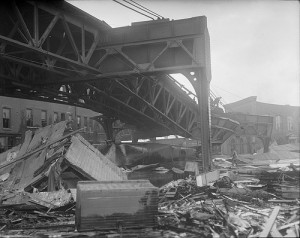Solving the Great Molasses Flood Mystery
-
-
slice.mit.edu
- 2
Filed Under
Recommended
Accusations and emotions run high after sensational disasters. To determine causes and liability, many MIT professors and alumni have served as expert witnesses or on fact-finding commissions. Almost a hundred years ago, Civil Engineering Department head Charles Spofford investigated and identified the cause of one of Boston’s most sensational disasters, the Great Molasses Flood.
On January 15, 1919, a 50-foot-high steel tank holding 2.3 million gallons of molasses suddenly ruptured in Boston’s North End. Flowing at the unexpected speed of 35 miles an hour, it formed a 15-foot high tsunami of 14,000 tons of viscous goop. Strong enough to knock houses off their foundations and sweep a train off its tracks, the wave killed 21 and injured 150 in the densely populated area.
Litigation swiftly followed and lasted for years. Three theories arose to explain the catastrophe: the tank exploded due to fermentation of the molasses; anarchists or Bolsheviks set off a bomb, or a structural failure led to disaster. US Industrial Alcohol, the company owning the tank, steadfastly blamed anarchists.
Among the litigants was the Boston Elevated train line, since the flood had severely damaged its overhead rail infrastructure in the North End. The company hired civil engineering professor Charles Spofford (Class of 1893), an authority on structural engineering and bridge design, to prove that USIA was at fault. Spofford examined and tested pieces of the tank at MIT labs.
According to Dark Tide: The Great Boston Molasses Flood of 1919 by Stephen Puleo, Spofford reported that the steel plates were thinner than the original plans had called for and could not withstand the pressure of so much molasses. In addition, the tank lacked enough rivets to properly fasten the plates. In fact, during the initial explosion, witnesses described rivets shooting out everywhere like machine gun bullets. With its weak walls and shortage of rivets, he concluded, “In my judgment, the tank was improperly designed and its failure was due entirely to structural weakness.”
Spofford calculated, “A stress as great as 18,000 pounds per square inch is as high as should have been permitted under any circumstances.” However, the fatal load of 2.3 million gallons exerted pressure of 31,000 pounds per square inch on the tank walls, “a figure nearly double that which should have been allowed.” He noted, “The factor of safety is but 1.8, while ordinary practice would have called for from 3 to 4.”
After several years of hearings, a court-appointed auditor found USIA responsible. Ultimately the company paid the modern equivalent of several million dollars in out-of-court settlements.
Spofford continued a distinguished career of teaching and research at MIT until retiring in 1940. He also was a founding member with Frederic Fay 1893 and Sturgis Thorndike 1895 of the engineering company Fay, Spofford & Thorndike, which now has offices in New York and New England.
Interested more MIT-flavored history? Read a Slice post about The Technologist, a historical thriller that pits members of MIT's first graduating class against an evil genius setting off disasters in the Boston area in in 1868.










Comments
Dick Dreselly
Sat, 01/09/2016 11:43pm
The comment I just submitted was for the author, not necessarily the wide world.
In the Website rectangle I put "ask Google", but your software converted that to "http://ask%20Google", which won't work.
Dick Dreselly
Sat, 01/09/2016 11:38pm
Thanks for the splendid interesting article. It reminds me that molasses is sugar, and sugar is bad for you. You wrote that Professor Spofford retired in 1940. I entered MIT in 1942, flunked out in 1944, returned to graduate in Course 1 in February 1947. I was in Professor Spofford's class on graphic stress analysis in 1946. Either your 1940 date is wrong, or he taught in MIT after that on an emeritus basis. I knew he was old (but younger than I am now), but thanks to your article now know he was in the 1893 class.
I wish I could remember the name of my excellent MIT geology professor. He was lanky and dashed around the classroom on crutches at what seemed 6 mph. He spoke often of being with Roy Chapman Andrews when he excavated dinosaur eggs and bones in Mongolia about 1924. Perhaps you can tell me his name, and write his story.